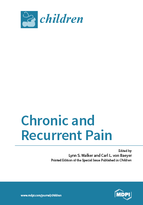Chronic and Recurrent Pain
A special issue of Children (ISSN 2227-9067).
Deadline for manuscript submissions: closed (31 August 2016) | Viewed by 162872
Special Issue Editors
Interests: chronic pain, functional gastrointestinal disorders, pain beliefs and coping
Special Issue Information
Dear Colleagues,
For many years, people assumed that children did not experience chronic pain. However, recent epidemiological studies show that chronic pain, defined as constant or recurrent pain lasting 3 months or longer, is common in childhood. Empirical studies have characterized chronic pain conditions including headache, abdominal pain, chest pain, and fibromyalgia. These pain conditions are associated with school absence, emotional distress, disruption in family activities, and significantly reduced quality of life in both the affected youth and their families.
Despite the prevalence and serious consequences of pediatric chronic pain, it is still under-recognized and under-treated. Too often, chronic pain is treated as a symptom of something else, rather than as a separate condition requiring its own treatment. The goal of this special issue is to discuss recent advances in the understanding and treatment of pediatric chronic pain.
The Special Issue contains 22 notable articles including original research, review, and commentary. Together they provide an excellent overview of the field of chronic and recurrent pediatric pain as it stands in 2016–17. Thanks to all the authors for their valuable contributions.
Dr. Lynn S. Walker
Dr. Carl L. von Baeyer
Guest Editors
Keywords
- Chronic pain
- Recurrent pain
- Pediatric/paediatric
- Infant
- Child
- Adolescent
- Headache
- Abdominal pain
- Migraine
- Back pain
- Limb pain
- Fibromyalgia







